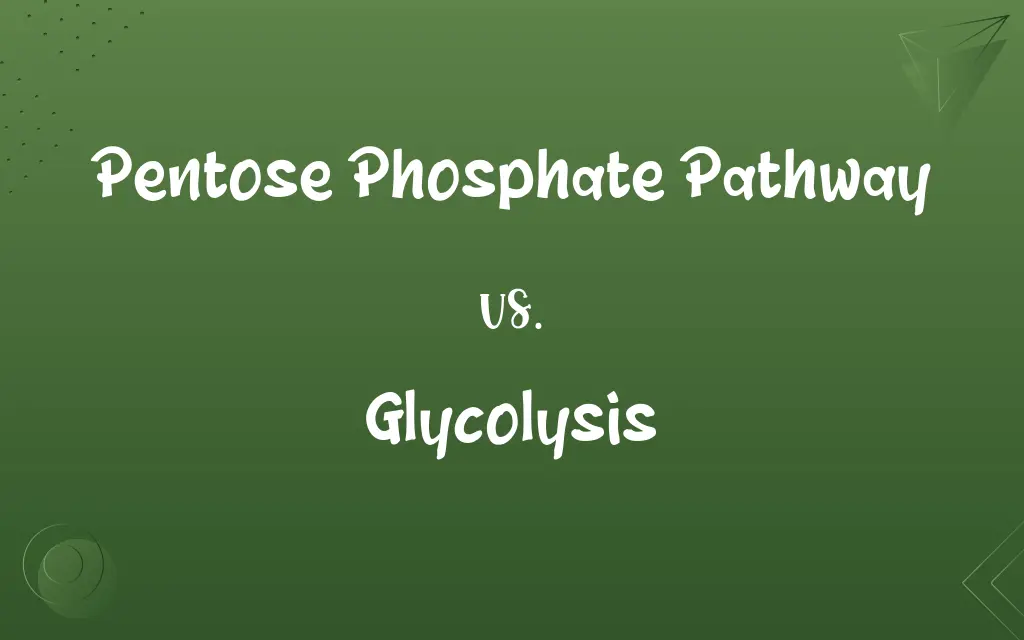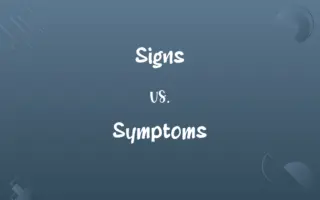Pentose Phosphate Pathway vs. Glycolysis: Know the Difference

By Shumaila Saeed || Published on December 25, 2023
The Pentose Phosphate Pathway generates NADPH and ribose-5-phosphate for biosynthesis, whereas Glycolysis breaks down glucose for energy (ATP) and pyruvate.

Key Differences
Pentose Phosphate Pathway (PPP) is a metabolic route primarily concerned with the production of NADPH, used in biosynthetic reactions, and ribose-5-phosphate, a component of nucleotides. This pathway operates parallel to glycolysis and does not directly contribute to ATP production. Glycolysis, in contrast, is a universal pathway for the breakdown of glucose to pyruvate, yielding ATP and NADH as primary products, essential for cellular energy.
Shumaila Saeed
Dec 25, 2023
The Pentose Phosphate Pathway plays a crucial role in cellular processes like fatty acid synthesis and the maintenance of redox balance through the generation of NADPH. It functions in both rapidly dividing cells and cells under oxidative stress. Glycolysis serves as a fundamental energy-yielding pathway for cells, operating in nearly all types of organisms, and is vital for both aerobic and anaerobic respiration.
Shumaila Saeed
Dec 25, 2023
PPP can be divided into two phases: the oxidative phase, which generates NADPH, and the non-oxidative synthesis of 5-carbon sugars. It’s more active in cells involved in synthesizing fatty acids and nucleotides. Glycolysis involves a series of ten enzymatic reactions, leading to the conversion of glucose to pyruvate, with the net production of two ATP molecules and two NADH molecules per glucose molecule.
Shumaila Saeed
Dec 25, 2023
The Pentose Phosphate Pathway is not a major contributor to energy production; its primary importance lies in anabolic reactions and in responding to oxidative stress. It’s particularly active in the liver, adipose tissue, adrenal glands, and red blood cells. Glycolysis is the primary pathway for energy production in cells, especially important when oxygen is scarce, as it does not require oxygen to produce energy.
Shumaila Saeed
Dec 25, 2023
In terms of regulation, the Pentose Phosphate Pathway is regulated by the availability of its substrates and the need for NADPH and ribose-5-phosphate in the cell. It adapts according to the cell’s metabolic needs. Glycolysis is tightly regulated by enzymes like hexokinase and phosphofructokinase, responding to the energy demands of the cell, ensuring efficient energy production and maintaining glucose homeostasis.
Shumaila Saeed
Dec 25, 2023
ADVERTISEMENT
Comparison Chart
Main Products
NADPH and ribose-5-phosphate for biosynthesis.
ATP and pyruvate for energy.
Shumaila Saeed
Dec 25, 2023
Role in Metabolism
Anabolic processes, producing biosynthetic precursors.
Catabolic processes, breaking down glucose for energy.
Shumaila Saeed
Dec 25, 2023
Oxygen Requirement
Operates independently of oxygen.
Anaerobic pathway, does not require oxygen.
Shumaila Saeed
Dec 25, 2023
Cellular Location
Occurs in the cytoplasm, particularly active in certain tissues like liver and red blood cells.
Also occurs in the cytoplasm of all cells.
Shumaila Saeed
Dec 25, 2023
Regulation
Regulated based on the need for NADPH and ribose-5-phosphate.
Tightly regulated by energy needs, key enzymes are hexokinase and phosphofructokinase.
Shumaila Saeed
Dec 25, 2023
ADVERTISEMENT
Pentose Phosphate Pathway and Glycolysis Definitions
Pentose Phosphate Pathway
It produces precursors for nucleotide biosynthesis.
Rapidly dividing cells rely on the Pentose Phosphate Pathway for DNA synthesis.
Shumaila Saeed
Dec 14, 2023
Glycolysis
It's a series of chemical reactions that occur in the cytoplasm of cells.
Glycolysis takes place in the cell's cytoplasm, not in the mitochondria.
Shumaila Saeed
Dec 14, 2023
Pentose Phosphate Pathway
A metabolic pathway generating NADPH and ribose-5-phosphate.
The Pentose Phosphate Pathway is essential for fatty acid synthesis in liver cells.
Shumaila Saeed
Dec 14, 2023
Glycolysis
Glycolysis is a metabolic pathway that breaks down glucose into pyruvate.
Glycolysis provides energy to cells by converting glucose into pyruvate.
Shumaila Saeed
Dec 14, 2023
Pentose Phosphate Pathway
An alternate glucose metabolic pathway, crucial for redox balance.
In red blood cells, the Pentose Phosphate Pathway helps in maintaining glutathione reduction.
Shumaila Saeed
Dec 14, 2023
ADVERTISEMENT
Glycolysis
This process generates ATP and NADH molecules.
Glycolysis produces ATP, which is used for various cellular activities.
Shumaila Saeed
Dec 14, 2023
Pentose Phosphate Pathway
Consists of oxidative and non-oxidative phases.
The oxidative phase of the Pentose Phosphate Pathway generates NADPH.
Shumaila Saeed
Dec 14, 2023
Glycolysis
Glycolysis doesn't require oxygen and is the first step in both aerobic and anaerobic respiration.
During anaerobic exercise, glycolysis helps produce energy without oxygen.
Shumaila Saeed
Dec 14, 2023
Pentose Phosphate Pathway
It's active in cells undergoing oxidative stress.
Cells combat oxidative damage using NADPH produced by the Pentose Phosphate Pathway.
Shumaila Saeed
Dec 14, 2023
Glycolysis
Glycolysis is a universal metabolic pathway found in all living organisms.
Glycolysis is essential for energy production in bacteria, plants, and animals.
Shumaila Saeed
Dec 14, 2023
Glycolysis
A metabolic process that occurs in nearly all living cells in which glucose is converted in a series of steps to pyruvic acid and during which energy is released in the form of ATP.
Shumaila Saeed
Dec 13, 2023
Glycolysis
(biochemistry) The cellular degradation of the simple sugar glucose to yield pyruvic acid, and ATP as an energy source
Shumaila Saeed
Dec 13, 2023
Glycolysis
A metabolic process that breaks down carbohydrates and sugars through a series of reactions to either pyruvic acid or lactic acid and release energy for the body in the form of ATP
Shumaila Saeed
Dec 13, 2023
Repeatedly Asked Queries
How does Glycolysis differ from the PPP?
Glycolysis primarily focuses on glucose breakdown for energy production, while PPP is more involved in generating NADPH and pentose sugars.
Shumaila Saeed
Dec 25, 2023
What is the primary purpose of the PPP?
The PPP primarily serves as a source of reducing power (NADPH) and precursor molecules for nucleotide synthesis.
Shumaila Saeed
Dec 25, 2023
What is the Pentose Phosphate Pathway (PPP)?
PPP is a metabolic pathway that generates NADPH and ribose-5-phosphate from glucose.
Shumaila Saeed
Dec 25, 2023
Where does the PPP occur in cells?
The PPP takes place in the cytoplasm of cells.
Shumaila Saeed
Dec 25, 2023
Is oxygen required for Glycolysis?
No, Glycolysis can occur in the absence of oxygen (anaerobic conditions).
Shumaila Saeed
Dec 25, 2023
Does Glycolysis occur in both aerobic and anaerobic conditions?
Yes, Glycolysis is the initial step in both aerobic and anaerobic respiration.
Shumaila Saeed
Dec 25, 2023
How many ATP molecules are produced in Glycolysis?
Glycolysis generates a net gain of 2 ATP molecules per glucose molecule.
Shumaila Saeed
Dec 25, 2023
What is the role of NADH in Glycolysis?
NADH produced in Glycolysis carries electrons to the electron transport chain during aerobic respiration.
Shumaila Saeed
Dec 25, 2023
What are the end products of Glycolysis?
The end products of Glycolysis are pyruvate, ATP, and NADH.
Shumaila Saeed
Dec 25, 2023
What are the different phases of Glycolysis?
Glycolysis consists of two phases: the energy investment phase and the energy payoff phase.
Shumaila Saeed
Dec 25, 2023
Where does Glycolysis take place within a cell?
Glycolysis occurs in the cytoplasm.
Shumaila Saeed
Dec 25, 2023
What is the overall purpose of Glycolysis?
The primary purpose of Glycolysis is to convert glucose into ATP and other energy-rich molecules.
Shumaila Saeed
Dec 25, 2023
What are some diseases associated with Glycolysis defects?
Glycogen storage diseases and some types of diabetes can result from Glycolysis defects.
Shumaila Saeed
Dec 25, 2023
What is the fate of pyruvate after Glycolysis?
In aerobic conditions, pyruvate enters the citric acid cycle. In anaerobic conditions, it may be converted to lactic acid.
Shumaila Saeed
Dec 25, 2023
Can Glycolysis occur in the absence of glucose?
Glycolysis can occur with other sugars like fructose and galactose as substrates, but glucose is the most common substrate.
Shumaila Saeed
Dec 25, 2023
Which step in Glycolysis produces NADH?
NADH is produced during the conversion of glyceraldehyde-3-phosphate to 1,3-bisphosphoglycerate.
Shumaila Saeed
Dec 25, 2023
Can you name an enzyme involved in Glycolysis?
One of the enzymes in Glycolysis is hexokinase.
Shumaila Saeed
Dec 25, 2023
How does PPP contribute to cell function?
PPP is crucial for providing NADPH for biosynthetic processes and maintaining redox balance.
Shumaila Saeed
Dec 25, 2023
Is Glycolysis anabolic or catabolic?
Glycolysis is a catabolic pathway as it breaks down glucose into smaller molecules.
Shumaila Saeed
Dec 25, 2023
How is glucose initially activated in Glycolysis?
Glucose is activated by phosphorylation with the help of ATP in the first step of Glycolysis.
Shumaila Saeed
Dec 25, 2023
Share this page
Link for your blog / website
HTML
Link to share via messenger
About Author
Written by
Shumaila SaeedShumaila Saeed, an expert content creator with 6 years of experience, specializes in distilling complex topics into easily digestible comparisons, shining a light on the nuances that both inform and educate readers with clarity and accuracy.









































































